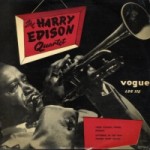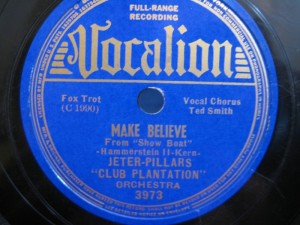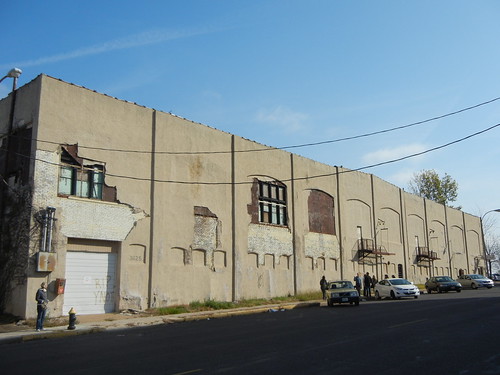by Kevin Belford, Christian Frommelt and Michael R. Allen
The Palladium Ballroom is located in the Grand Center Arts and Entertainment District of St. Louis. With Delmar Boulevard to the South, Enright Avenue to the North, and Grand Avenue to the East, the Palladium is one of a fraction of historic entertainment buildings which have remained since the early twentieth century, and one of the few remaining entertainment venues in St. Louis which provided both music for social dancing and floor shows to watch.

Appearing on the scene in the final days of ragtime and the earliest days of the jazz age, the Palladium was host to St. Louis’ early jazz bands. Continuing into the war years it was the Club Plantation, St. Louis’ gangster-run jazz and swing night club like the famous Cotton Club in Harlem, New York City. From its construction in 1913 through the early 1950s, the building has been associated with important musicians involved in both local and national development of dance, jazz and swing music.
The Grand Amusement Company obtained a building permit for The Palladium on August 18, 1913. The permit shows a construction cost of $35,000 for a two-story building with stores and skating rink. The dimensions reported were 152 feet by 220 feet. The permit also noted iron girders, a composition roof, terra cotta cornices and steam heat. Charles N. Lund was the contractor, and his office address was the same as the owner’s: 415 Burlington Building. James S. Lee was the architect, and his office was located at 6038 Delmar Avenue. Little is known about Lee.

The Grand Amusement Company opened the Palladium Rink as a roller skating rink on December 29, 1913. Soon after the opening, the company initiated what would become a strong association with local and national music and dance acts with a Sunshine Society’s Benefit Ball on January 19, 1914. Thomas Allan Rector and Irmgard Blebiger were the feature attraction and showcased, “the Argentine Tango, the Brazillian Maxixe, the Vienna ‘Hesitation’ waltz, and other modern steps.” 1000 couples were expected to attend the ball to dance throughout the evening to Gene Rodemich’s Orchestra, the first St. Louis jazz band to have its music recorded. After 13 continuous seasons, the rink was scheduled to reopen on September 9, 1926 after floor resurfacing, renewing skates, and comprehensive redecorating. New programming included Wednesday and Thursday party and club nights, Friday ladies’ nights, and a special feature each Saturday.
The building at 3618 Enright remained the Palladium Roller Skating Rink until 1940 when the Plantation Club night club, which had existed on the west end of the block at 911 North Vandeventer since 1931, replaced the roller skating rink. Almost certainly modeled after the successful Cotton Club, which opened in Harlem, New York in 1920, the Plantation Club offered the best working conditions and wages for blacks while also being the first venue to offer top black entertainment to a whites-only clientele. The St. Louis gangster, Tony Scarpelli owned the Club Plantation. The club operated as a set-ups nightclub, meaning they sold food and provided ice, soft drinks, and glasses and the customers brought their own liquor. This way they could stay open later than the 1 o’clock curfew for taverns– a liquor law work-around.

Scarpelli and other owners altered the building to fit changing uses. The city issued a substantial permit for alterations to the building to the Palladium Amusement Company on July 20, 1922. The cost of these unknown alterations was $3,200 with Lund serving as contractor. Additional permits for significant alterations date to 1933 and 1940. These are all interior remodeling projects.

As a 1942 Billboard review remarks, increased soldier and defense worker patronage provided for booming business and that year the venue installed air-conditioning units and booked a summer schedule. The Plantation Club also avoided the 1:30 am curfew through its set-up-only policy and drew its largest numbers in the early hours of the morning, offering shows at 11 pm, 1 am, and 3 am. Jeter-Pillars Orchestra, a well-established local band that included Harry “Sweets” Edison and Clark Terry, served to be the usual featured band, but top names in jazz and pop of the time, such as Jimmie Lunceford, the Mills Brothers, Nat King Cole, Ella Fitzgerald, Benny Carter, and others also regularly performed at the Plantation Club in conjunction with national dance acts and floor shows.
At the Club Plantation, two extraordinary young musicians joined the Jeter-Pillars Orchestra, bassist Jimmy Blanton and guitarist Charlie Christian. In 1939, Duke Ellington dropped by the club and hired away Blanton who, more than anyone else in jazz, made the string bass a solo instrument. In September of 1939, record producer John Hammond heard Christian playing with the Jeter-Pillars band and recommended him to Benny Goodman. The Jeter-Pillars Orchestra also saw in its ranks, Jimmy Forrest who recorded the hit single, Night Train.

By 1942, the Jeter-Pillars Orchestra became the most popular band in St. Louis with local radio shows on WIL and KMOX, and being featured on the national radio program, The Fitch Bandwagon. Popular St. Louis bandleader, Eddie Johnson talked about his memories of the Club Plantation,â€
I had a band that was twelve pieces. I had a chance to work with all these top bands in the country, like McKinney’s Cotton Pickers, Fate Marable, Duke Ellington … I opened the Plantation Club back in 1931, that’s when I had a fellow called Tab Smith in my band.

In the interview, Johnson named a number of other St. Louis clubs from the 1930s, such as the Dance Box, the Chauffers’ Club, and the Finance Building but none of those landmarks remain today. The Jeter-Pillars Orchestra backed many popular national talents when they came to town including Louis Jordan. The biographies of Dizzy Gillespie and Miles Davis talk of the Club Plantation and the St. Louis jazz bands of George Hudson and the visiting orchestra of Billy Eckstine’s. Davis was eighteen years old and sat in with Eckstine and local trumpet man Clark Terry was in Hudson’s band. Terry remembered the Plantation orchestras as having the best local talent and being known nationally for their excellent musicianship:
We played the Club Plantation and all the acts from Nat King Cole to Ella Fitzgerald, Sarah Vaughan, the Nicholas Brothers – all acts came to the Club Plantation because it was a very, very popular place. They brought their music and we would play their music better than anybody ever played it. They would hear the music played like they’d never heard it played before. They would go all over the country, “Man, you got to go out to St. Louis and have that George Hudson band play your music. You’ll never ever hear it played like that.” So that’s how the band got their reputation. It was a great band.
The Club Plantation occupied the building at 3617 Delmar Boulevard until the early 1950s. A significant building permit dates to April 7, 1949, and encompasses alterations to a “bowling alley.” The owner reported was Nat Gordon, and the cost was $7,500. It is likely that the stucco cladding was part of these alterations since no other permit seems to correspond with that work. The city issued permits for small alterations to the Palladium until 1962, with one permit dating to May 27, 1952 with a reported cost of $8,000 possibly corresponding to major interior alterations.

While various taverns and bars have passed in and out of the building’s storefronts, it is Veteran’s Village Clothing, which occupied the space between 1963 and 2006, that has kept the building in use and extant. In 2011, the owner of the thrift store passed away and the store was closed. Currently, the building is vacant. Recently, the Veterans Administration expressed interest in purchasing the building for expansion of the John Cochran Veterans Hospital to the north across Enright. Yet the Veterans Administration has not purchased the building yet, and its actions are subject to public input and the National Historic Preservation Act. Whether the Palladium remains standing as a reminder of St. Louis’ rich 20th century musical heritage ultimately is our choice as a city. Will we take action to keep it standing?

7 replies on “The Palladium Made St. Louis Music History; What Will We Make of the Palladium?”
I know someone that wants to work to save it, but he is having no luck finding info on who the owners are and how to contact them. Can you help?
Get hold of Kevin Belford in Kirkwood.
try Vincent C. Schoemehl, Jr. vince@grandcenter.org • 314-289-1502
In 1944 Art Blakey joined the Billy Eckstine Band at The Plantation!
Apparently Club Plantation (as indeed the name suggests) operated a whites-only color bar. There is a brochure issued by them and reproduced in “Miles Davis: The Complete Illustrated History” p. 19 which states unambiguously in bold letters ‘STRICTLY WHITE PATRONAGE ONLY’ above a crude racial stereotype. It’s interesting that both musicians and historians pass silently over this aspect of this establishment. How long was it a whites-only venue? Was this commonplace? When did this practice stop in St. Louis? Did the musicians and waiters have to wear special ‘plantation’ outfits like the Cotton Club (which obviously was the model for this establishment). Landmark it might have been but perhaps not the beacon of culture you might like to paint it as, to the black community anyway. No wonder Miles et al. strove so hard to get away from this hellhole.
Re-read your item and must say am truly baffled by your blindness to this key aspect of Club Plantation’s practice. Baffled? Well that’s to put it mildly…… Would you care to comment?
I have a picture of my grandmother and “Skeets” Shaw, bandleader, taken at the Club Plantation in 1946. I have been trying to find out exactly who he was and if he was any relation to Artie Shaw. I think his real name was Denny D. Shaw but have been able to find nothing on him other than a couple of songs registered to him in the Library of Congress. My grandmother was in St. Louis a few times, Los Angeles, Buffalo but settled back in Cincinnati. The picture is really cool with some hand written notes on the back from Skeets Shaw. Any help appreciated rccintioh@gmail.com Richard Carpenter, Cincinnati, OH